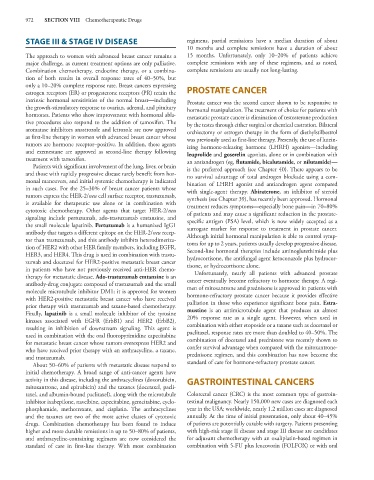Page 986 - Basic _ Clinical Pharmacology ( PDFDrive )
P. 986
972 SECTION VIII Chemotherapeutic Drugs
STAGE III & STAGE IV DISEASE regimens, partial remissions have a median duration of about
10 months and complete remissions have a duration of about
The approach to women with advanced breast cancer remains a 15 months. Unfortunately, only 10–20% of patients achieve
major challenge, as current treatment options are only palliative. complete remissions with any of these regimens, and as noted,
Combination chemotherapy, endocrine therapy, or a combina- complete remissions are usually not long-lasting.
tion of both results in overall response rates of 40–50%, but
only a 10–20% complete response rate. Breast cancers expressing
estrogen receptors (ER) or progesterone receptors (PR) retain the PROSTATE CANCER
intrinsic hormonal sensitivities of the normal breast—including Prostate cancer was the second cancer shown to be responsive to
the growth-stimulatory response to ovarian, adrenal, and pituitary hormonal manipulation. The treatment of choice for patients with
hormones. Patients who show improvement with hormonal abla- metastatic prostate cancer is elimination of testosterone production
tive procedures also respond to the addition of tamoxifen. The by the testes through either surgical or chemical castration. Bilateral
aromatase inhibitors anastrozole and letrozole are now approved orchiectomy or estrogen therapy in the form of diethylstilbestrol
as first-line therapy in women with advanced breast cancer whose was previously used as first-line therapy. Presently, the use of lutein-
tumors are hormone receptor–positive. In addition, these agents izing hormone-releasing hormone (LHRH) agonists—including
and exemestane are approved as second-line therapy following leuprolide and goserelin agonists, alone or in combination with
treatment with tamoxifen. an antiandrogen (eg, flutamide, bicalutamide, or nilutamide)—
Patients with significant involvement of the lung, liver, or brain is the preferred approach (see Chapter 40). There appears to be
and those with rapidly progressive disease rarely benefit from hor- no survival advantage of total androgen blockade using a com-
monal maneuvers, and initial systemic chemotherapy is indicated bination of LHRH agonist and antiandrogen agent compared
in such cases. For the 25–30% of breast cancer patients whose with single-agent therapy. Abiraterone, an inhibitor of steroid
tumors express the HER-2/neu cell surface receptor, trastuzumab, synthesis (see Chapter 39), has recently been approved. Hormonal
is available for therapeutic use alone or in combination with treatment reduces symptoms—especially bone pain—in 70–80%
cytotoxic chemotherapy. Other agents that target HER-2/neu of patients and may cause a significant reduction in the prostate-
signaling include pertuzumab, ado-trastuzumab emtansine, and specific antigen (PSA) level, which is now widely accepted as a
the small molecule lapatinib. Pertuzumab is a humanized IgG1 surrogate marker for response to treatment in prostate cancer.
antibody that targets a different epitope on the HER-2/neu recep- Although initial hormonal manipulation is able to control symp-
tor than trastuzumab, and this antibody inhibits heterodimeriza- toms for up to 2 years, patients usually develop progressive disease.
tion of HER2 with other HER family members, including EGFR, Second-line hormonal therapies include aminoglutethimide plus
HER3, and HER4. This drug is used in combination with trastu- hydrocortisone, the antifungal agent ketoconazole plus hydrocor-
zumab and docetaxel for HER2-positive metastatic breast cancer
in patients who have not previously received anti-HER chemo- tisone, or hydrocortisone alone.
therapy for metastatic disease. Ado-trastuzumab emtansine is an Unfortunately, nearly all patients with advanced prostate
antibody-drug conjugate composed of trastuzumab and the small cancer eventually become refractory to hormone therapy. A regi-
molecule microtubule inhibitor DM1; it is approved for women men of mitoxantrone and prednisone is approved in patients with
with HER2-positive metastatic breast cancer who have received hormone-refractory prostate cancer because it provides effective
prior therapy with trastuzumab and taxane-based chemotherapy. palliation in those who experience significant bone pain. Estra-
Finally, lapatinib is a small molecule inhibitor of the tyrosine mustine is an antimicrotubule agent that produces an almost
kinases associated with EGFR (ErbB1) and HER2 (ErbB2), 20% response rate as a single agent. However, when used in
resulting in inhibition of downstream signaling. This agent is combination with either etoposide or a taxane such as docetaxel or
used in combination with the oral fluoropyrimidine capecitabine paclitaxel, response rates are more than doubled to 40–50%. The
for metastatic breast cancer whose tumors overexpress HER2 and combination of docetaxel and prednisone was recently shown to
who have received prior therapy with an anthracycline, a taxane, confer survival advantage when compared with the mitoxantrone-
and trastuzumab. prednisone regimen, and this combination has now become the
About 50–60% of patients with metastatic disease respond to standard of care for hormone-refractory prostate cancer.
initial chemotherapy. A broad range of anti-cancer agents have
activity in this disease, including the anthracyclines (doxorubicin, GASTROINTESTINAL CANCERS
mitoxantrone, and epirubicin) and the taxanes (docetaxel, pacli-
taxel, and albumin-bound paclitaxel), along with the microtubule Colorectal cancer (CRC) is the most common type of gastroin-
inhibitor ixabepilone, navelbine, capecitabine, gemcitabine, cyclo- testinal malignancy. Nearly 150,000 new cases are diagnosed each
phosphamide, methotrexate, and cisplatin. The anthracyclines year in the USA; worldwide, nearly 1.2 million cases are diagnosed
and the taxanes are two of the most active classes of cytotoxic annually. At the time of initial presentation, only about 40–45%
drugs. Combination chemotherapy has been found to induce of patients are potentially curable with surgery. Patients presenting
higher and more durable remissions in up to 50–80% of patients, with high-risk stage II disease and stage III disease are candidates
and anthracycline-containing regimens are now considered the for adjuvant chemotherapy with an oxaliplatin-based regimen in
standard of care in first-line therapy. With most combination combination with 5-FU plus leucovorin (FOLFOX) or with oral

